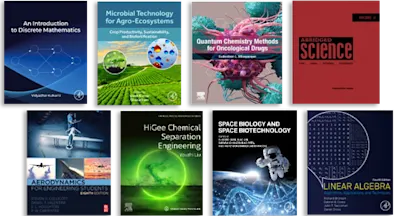
Composite Overwrapped Pressure Vessels (COPV)
Design and Safe Operations for Aerospace and Automotive Applications
- 1st Edition - February 1, 2026
- Latest edition
- Author: Michael T. Kezirian
- Language: English
- Hardback ISBN:9 7 8 - 0 - 4 4 3 - 4 0 3 9 1 - 0
- eBook ISBN:9 7 8 - 0 - 4 4 3 - 4 0 3 9 2 - 7
Composite Overwrapped Pressure Vessels (COPV): Design and Safe Operations for Aerospace and Automotive Applications facilitates acquisition of the technical skillsets essent… Read more

Composite Overwrapped Pressure Vessels (COPV): Design and Safe Operations for Aerospace and Automotive Applications facilitates acquisition of the technical skillsets essential to navigate design, manufacture, qualification and acceptance testing, handling, and operation of these complex systems.
The book follows a cogent structure that accompanies readers through an introductory historical evolution of the pressure vessel industry and discussions of applications for both the aerospace and automotive sectors, to then delve into manufacturing specifications and processes as the two industries have relatively different approaches to certification. Safely using pressure vessels, however, primarily requires an understanding of hazards and their corresponding failure modes, which establish and regulate specific requirements to mitigate any associated risks. Coherent with this objective, an overview of standards developed by the AIAA, CGA, and ISO is presented to provide a framework for quality management and is followed by rigorous coverage of analytical aspects, including computational models, non-destructive inspection techniques, and testing methodologies to verify reliability of the COPVs devised. The practical insights on operational considerations and end-of-life scenarios conclude this in-depth investigation, ensuring that engineering professionals and academic audiences alike are offered a well-rounded resource to further advance optimized, but also cost-effective real-world utilization of this revolutionary storage hardware for pressurized fluids in launch vehicles, spacecraft, and hydrogen or natural gas-fueled ground vehicles.
The book follows a cogent structure that accompanies readers through an introductory historical evolution of the pressure vessel industry and discussions of applications for both the aerospace and automotive sectors, to then delve into manufacturing specifications and processes as the two industries have relatively different approaches to certification. Safely using pressure vessels, however, primarily requires an understanding of hazards and their corresponding failure modes, which establish and regulate specific requirements to mitigate any associated risks. Coherent with this objective, an overview of standards developed by the AIAA, CGA, and ISO is presented to provide a framework for quality management and is followed by rigorous coverage of analytical aspects, including computational models, non-destructive inspection techniques, and testing methodologies to verify reliability of the COPVs devised. The practical insights on operational considerations and end-of-life scenarios conclude this in-depth investigation, ensuring that engineering professionals and academic audiences alike are offered a well-rounded resource to further advance optimized, but also cost-effective real-world utilization of this revolutionary storage hardware for pressurized fluids in launch vehicles, spacecraft, and hydrogen or natural gas-fueled ground vehicles.
- Elucidates the complexities associated with the use of pressure vessels to store compressed liquids and gases
- Enables understanding of the approaches employed by the aerospace and automotive industries to design, certify, and operate composite overwrapped pressure vessels
- Establishes safety requirements and the methods for verification of compliance to manufacturing standards
Aerospace and automotive engineers; safety managers and systems engineering specialists working for aerospace/automotive agencies; aerospace/automotive certification bodies; manufacturing companies involved with COPV design, development, and testing; professional and academic graduate-level courses in aerospace/automotive engineering, applied mechanical engineering, materials science for vehicle engineering
1. Pressure Vessels in the Aerospace Sector
2. Pressure Vessels in the Automotive Sector
3. Manufacturing of Pressure Vessels
4. Hazards of Pressure Vessels
5. Standards – Requirements to Mitigate Hazards
6. Pressure Vessel Analysis
7. Pressure Vessel Finite Element Analysis
8. Fatigue and Fracture (Metallic Liner)
9. Non-destructive Inspection Techniques
10. Testing of Pressure Vessels
11. Acoustic, Vibration, and Load Testing
12. Operational Considerations
2. Pressure Vessels in the Automotive Sector
3. Manufacturing of Pressure Vessels
4. Hazards of Pressure Vessels
5. Standards – Requirements to Mitigate Hazards
6. Pressure Vessel Analysis
7. Pressure Vessel Finite Element Analysis
8. Fatigue and Fracture (Metallic Liner)
9. Non-destructive Inspection Techniques
10. Testing of Pressure Vessels
11. Acoustic, Vibration, and Load Testing
12. Operational Considerations
- Edition: 1
- Latest edition
- Published: February 1, 2026
- Language: English
MK
Michael T. Kezirian
Dr. Kezirian has a Bachelors from Brown University (1989) and a Masters and Doctorate from the Massachusetts Institute of Technology (1992 and 1996 respectively), all in Chemical Engineering. He was an Associate Technical Fellow at the Boeing Company, most recently supporting the development of the Boeing Starliner CST-100, through the NASA Commercial Crew Program. For the Space Shuttle Program, he was the Boeing Safety Representative to the Mission Management Team and responsible for all safety products related to flight operations including flight readiness reviews and the resolution of on-orbit anomalies. In the Return to Flight activities following the Space Shuttle Columbia accident, Dr. Kezirian became the analysis lead of an integrated NASA cross agency to develop flight rationale to permit continued Shuttle flight operations. He is also a Fellow Member of IAASS, an Associate Fellow of the AIAA, and a member of the AIAA Standards Steering Committee, for which he oversaw the development of new standards for pressure vessels. He now teaches IAASS-sponsored, industry-focused courses on COPV design, certification, and operations. Dr. Kezirian is President of the International Space Station Foundation and is the founding editor-in-chief of the Journal of Space Safety Engineering, published by Elsevier. In 2009, he was awarded the NASA Astronaut Personal Achievement Award (Silver Snoopy).
Affiliations and expertise
Adjunct Professor of Astronautics Practice, Viterbi School of Engineering, University of Southern California, Los Angeles, CA, USA